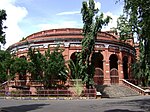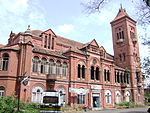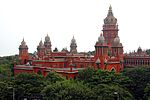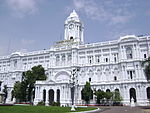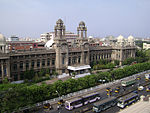Here is the slideshow of 99 Flowers with pictures mentioned in Tamil Literature on 100 BCE-100 CE, with their botanical name
99 Tamil Flowers from Palaniappan Vairam Sarathy
Kurincippattu (Tamil: குறிஞ்சிப்பாட்டு) is a Tamil poetic work of Tamil literature, belonging to the Sangam period corresponding to between 100 BCE – 100 CE. ”Kurincippattu” describes the kurinchi landscape of
the mountainous terrain and mentions almost 100 different plant names
along side the main storyline of the the love affair between the hero
and the heroine. The poems were written by the poet Kapilar. Below are the lines from Kurunjippaatu
வள் இதழ்
ஒண் செங் காந்தள், ஆம்பல், அனிச்சம்,
தண் கயக் குவளை, குறிஞ்சி, வெட்சி,
செங் கொடுவேரி, தேமா, மணிச்சிகை,
உரிது நாறு அவிழ் தொத்து உந்தூழ், கூவிளம், 65
எரி புரை எறுழம், சுள்ளி, கூவிரம்,
வடவனம், வாகை, வான் பூங் குடசம்,
எருவை, செருவிளை, மணிப் பூங் கருவிளை,
பயினி, வானி, பல் இணர்க் குரவம்,
பசும்பிடி, வகுளம், பல் இணர்க் காயா, 70
விரி மலர் ஆவிரை, வேரல், சூரல்,
குரீஇப் பூளை, குறுநறுங் கண்ணி,
குருகிலை, மருதம், விரி பூங் கோங்கம்,
போங்கம், திலகம், தேங் கமழ் பாதிரி,
செருந்தி, அதிரல், பெருந் தண் சண்பகம், 75
கரந்தை, குளவி, கடி கமழ் கலி மா,
தில்லை, பாலை, கல் இவர் முல்லை,
குல்லை, பிடவம், சிறுமாரோடம்,
வாழை, வள்ளி, நீள் நறு நெய்தல்,
தாழை, தளவம், முள் தாள் தாமரை, 80
ஞாழல், மௌவல், நறுந் தண் கொகுடி,
சேடல், செம்மல், சிறுசெங்குரலி,
கோடல், கைதை, கொங்கு முதிர் நறு வழை,
காஞ்சி, மணிக் குலைக் கள் கமழ் நெய்தல்,
பாங்கர், மராஅம், பல் பூந் தணக்கம், 85
ஈங்கை, இலவம், தூங்கு இணர்க் கொன்றை,
அடும்பு, அமர் ஆத்தி, நெடுங் கொடி அவரை,
பகன்றை, பலாசம், பல் பூம் பிண்டி,
வஞ்சி, பித்திகம், சிந்துவாரம்,
தும்பை, துழாஅய், சுடர்ப் பூந் தோன்றி, 90
நந்தி, நறவம், நறும் புன்னாகம்,
பாரம், பீரம், பைங் குருக்கத்தி,
ஆரம், காழ்வை, கடி இரும் புன்னை,
நரந்தம், நாகம், நள்ளிருள் நாறி,
மா இருங் குருந்தும், வேங்கையும், பிறவும், 95
அரக்கு விரித்தன்ன பரு ஏர்அம் புழகுடன்,
ஒண் செங் காந்தள், ஆம்பல், அனிச்சம்,
தண் கயக் குவளை, குறிஞ்சி, வெட்சி,
செங் கொடுவேரி, தேமா, மணிச்சிகை,
உரிது நாறு அவிழ் தொத்து உந்தூழ், கூவிளம், 65
எரி புரை எறுழம், சுள்ளி, கூவிரம்,
வடவனம், வாகை, வான் பூங் குடசம்,
எருவை, செருவிளை, மணிப் பூங் கருவிளை,
பயினி, வானி, பல் இணர்க் குரவம்,
பசும்பிடி, வகுளம், பல் இணர்க் காயா, 70
விரி மலர் ஆவிரை, வேரல், சூரல்,
குரீஇப் பூளை, குறுநறுங் கண்ணி,
குருகிலை, மருதம், விரி பூங் கோங்கம்,
போங்கம், திலகம், தேங் கமழ் பாதிரி,
செருந்தி, அதிரல், பெருந் தண் சண்பகம், 75
கரந்தை, குளவி, கடி கமழ் கலி மா,
தில்லை, பாலை, கல் இவர் முல்லை,
குல்லை, பிடவம், சிறுமாரோடம்,
வாழை, வள்ளி, நீள் நறு நெய்தல்,
தாழை, தளவம், முள் தாள் தாமரை, 80
ஞாழல், மௌவல், நறுந் தண் கொகுடி,
சேடல், செம்மல், சிறுசெங்குரலி,
கோடல், கைதை, கொங்கு முதிர் நறு வழை,
காஞ்சி, மணிக் குலைக் கள் கமழ் நெய்தல்,
பாங்கர், மராஅம், பல் பூந் தணக்கம், 85
ஈங்கை, இலவம், தூங்கு இணர்க் கொன்றை,
அடும்பு, அமர் ஆத்தி, நெடுங் கொடி அவரை,
பகன்றை, பலாசம், பல் பூம் பிண்டி,
வஞ்சி, பித்திகம், சிந்துவாரம்,
தும்பை, துழாஅய், சுடர்ப் பூந் தோன்றி, 90
நந்தி, நறவம், நறும் புன்னாகம்,
பாரம், பீரம், பைங் குருக்கத்தி,
ஆரம், காழ்வை, கடி இரும் புன்னை,
நரந்தம், நாகம், நள்ளிருள் நாறி,
மா இருங் குருந்தும், வேங்கையும், பிறவும், 95
அரக்கு விரித்தன்ன பரு ஏர்அம் புழகுடன்,
Source and Courtesy : KarkaNirka.org , Wikipedia


















